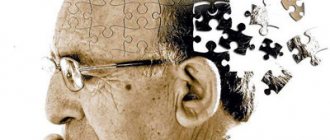HEBOID SYNDROME
(Greek, hebe youth, puberty, eidos appearance; synonym:
psychopath-like syndrome, pseudocharacterological syndrome, parathymia, mattoid
) - a syndrome of mental disorder that occurs at a young age with an exaggeration and modification of psychological pubertal properties, a predominance of affective-volitional disorders, including h. and drives that lead to behavior contrary to generally accepted norms and pronounced maladjustment in society. G. s. The phenomena of mental immaturity and autochthonously occurring phase affective disorders are inherent in varying severity. G. s. observed in schizophrenia within the framework of a low-progressive form of the course, but also occurs in the initial period of its other forms. Less often G. s. described in some forms of psychopathy (heboid, emotionally stupid).
The uniqueness of emotional disorders, combined with the relative preservation of intellectual functions, served as the basis for classifying G. as. to the so-called moral insanity, which was described as an independent disease. Within its framework, psychopathologically and nosologically different conditions were combined on a symptomatic basis. Nowadays, this concept is of only historical interest.
Clinical picture
G. s. is manifested by previously uncharacteristic rudeness and hostility in relationships with others, with meaningless opposition and negativism to the generally accepted way of life, elevating everything negative to authority. Characterized by ugly and caricatured forms of imitation of fashion in clothing, eccentricity and pretentiousness of appearance and behavior in general, deliberate swagger and clowning. Despite the preserved intellectual capabilities, the ability for purposeful, systematic activity is gradually lost. The interests and activities of patients take on the character of unproductive “extra-valuable” hobbies or aimless pastimes and are largely determined by the increasing weakening of self-control. Patients drop out of school, go to work irregularly, wander the streets idle without thinking, go to other cities to “experience life,” easily fall under the influence of antisocial individuals and commit crimes. In some patients, disinhibition of sexual desire, excessive consumption of alcoholic beverages and drug use, and gambling come to the fore. This behavior of patients is completely uncorrectable and can be mistakenly regarded as undisciplined.
For patients who have G. s. develops at early puberty (11-14 years), characterized by a tendency to patol, fantasizing, often of sadistic content. The behavior is dominated by a negativistic attitude towards relatives with unmotivated hostility and hatred towards them, persistent terrorizing them with unfounded claims, sophisticated cruelty and causeless aggression (the so-called delirium of actions and family hatred, in the terminology of French psychiatrists). G. s., which arises in adolescence (15-17 years), is characterized by a persistent desire to resolve abstract problems with a simultaneous departure from really significant activities (so-called metaphysical intoxication, dogmatic delirium). At the same time, the judgments of patients lack depth of understanding of problems and are often imitative; reform plans are projected without taking into account real possibilities and the situation, and are accompanied by empty opposition and claims to an original worldview.
Patients with G. s. characterized by inadequacy, low motivation and often perverted nature of emotional reactions and drives. Feelings of sympathy, compassion, and duty sharply decrease; a complete disregard for ethical ideas and indifference to the opinions of others is revealed. On external manifestations of G. s. social factors influence.
Pathogenetically G. s. associated with puberty. In patients with G. s. There is often a hereditary burden of psychopathy of the schizoid circle.
What is psychopathic-like schizophrenia?
Teenagers are most prone to developing pathology
The second name of the disease is pseudopsychopathic schizophrenia. The pathology is characterized by a severe personality disorder with moderate manifestation of schizophrenic symptoms, such as acute delusions and hallucinations. Pathology refers to diseases with a slow progression, which is why it is often referred to as a sluggish form of schizophrenia.
In the vast majority of cases, the disease appears in adolescents. It remains undiagnosed for a long time, since behavioral characteristics are often mistakenly associated with puberty.
As with other types of illness, the causes of psychopathic-like schizophrenia remain questionable. Recently, doctors have begun to classify this form of the disease as endogenous psychopathology, that is, caused by malfunctions in the body. In this regard, a potential cause of the development of pathology may be:
- neurochemical imbalance;
- disruption of the central nervous system due to intoxication;
- organic brain diseases;
- epilepsy;
- genetic predisposition.
The leading role is played by a neurochemical imbalance, manifested by changes in the production of serotonin, dopamine and acetylcholine. As a result of this failure, personality changes and psychopathic-like behavior are observed.
Another suspected cause is disruption of the central nervous system due to poisoning with heavy metal salts, drug or alcohol intoxication. The influence of illicit substances and alcohol on the development of psychopathology is supported by the average age of patients, since it is in adolescence that the desire to try alcohol and illicit substances most often appears.
One of the leading factors in the development of schizophrenia of any type is genetic predisposition. In the case of schizoaffective disorders, which include psychopathic-like schizophrenia, the risk of developing the disease increases if there is a family history of schizophrenia and other pathologies, for example, bipolar affective disorder. Moreover, the more often mental illnesses (not just schizophrenia) occurred in the family, the higher the risk of developing this pathology.
Pure psychopathy is one of the personality disorders accompanied by aggressive behavior. With this syndrome, no physiological problems are observed, but a psychopath is a person who clearly stands out for his callousness, impulsiveness, anger, lack of ability to empathize with the grief of others, etc.
Psychopathy as a definition has been known in medicine for a very long time; recently it has been called a personality disorder.
Diagnosis
Differential diagnosis is carried out with mental manifestations of physiol, pubertal crisis, with antisocial forms of behavior of persons with drive disorders (for example, in psychopathic states due to organic brain damage after encephalitis, traumatic brain injury, with endocrinopathies, mental retardation, hron, alcoholism, etc.). For G. s. Schizophrenia is characterized by inappropriate actions with the loss of their connection with the real situation, loss of emotional interest in the environment, monotonous and stereotypical nature of activity, often taking the form of “overvalued” drives. The presence of other productive symptoms (eg, delusional, catatonic, etc.) and thinking disorders helps the diagnosis.
How to cure psychopathic schizophrenia
Psychopathy is a form of psychosis accompanied by personality pathology, cynicism, aggressive behavior, a tendency to use drugs and alcohol, and callousness. These signs are characteristic of a mild neurosis-like form of schizophrenia.
With the nosology, social adaptation is disrupted, the psyche suffers, but delusional-hallucinatory syndrome rarely develops only in acute cases.
Doctors first started talking about psychopathy in 1884, when the term “psychopath” appeared in medicine. The nosology was identified after studying the condition of a certain defendant who committed a violent act against a friend. When trying to determine the woman’s sanity, psychiatrists determined that the defendant did not have any significant mental pathology to consider her insane.
Advice
At the same time, experts identified a new nosological form, indicating some abnormality in the patient’s psyche. Such people, due to their temperament, have increased anxiety. Sometimes, during times of great excitement, they commit actions that are contrary to morality.
Subsequent study of psychopathy led to the identification of new signs of the disease with acquired and congenital traits. Significant difficulties are caused by identifying nosology at an early stage.
Treatment
Treatment is symptomatic and includes the use of tranquilizers, neyleptil, haloperidol, and in more severe cases - mazeptil. The prognosis depends on the course of the underlying disease. In a low-progressive form of schizophrenia, with the end of puberty, a noticeable reduction in G.'s symptoms occurs, and social and work adaptation is restored. G. s. usually does not recur, however, in those who have suffered it, a certain “sex” of the personality is observed with clear signs of mental retardation, leveling of the most striking individual properties and emotional-volitional qualities.
Bibliography:
Vitebskaya K. S. About heboid syndrome in schizophrenia at puberty, Zhurn, neuropath, and psychiat., t. 58, no. 7, p. 867, 1958; Panteleeva G.P. About protracted heboid states in schizophrenia, ibid., vol. 71, no. 1, p. 125, 1971; about the same, On the outcomes of protracted schizophrenic heboid states, ibid., vol. 73, no. 6, p. 909, 1973, bibliogr.; P about p about in and A. N. and Shmaonova L. M. Prognostic value of heboid syndrome in schizophrenia, in the same place, t. 69, No. 12, p. 1843, 1969; Sukhareva G. E. Clinic of schizophrenia in children and adolescents, Kharkov, 1937; Tsutsulkovskaya M. Ya. and Panteleeva G. P. On the issue of clinical manifestations of heboid syndrome in schizophrenia in adolescence, in the book: Problems, organization of psychiatry, assistance, wedge, and epidemiol, mental diseases, ed. E. Ya. Sternberg, part 1, p. 107, M., 1970; Carraz Y. Aux frontifcres de la schizophr6nie, PhSboi-dophr6nie, EncGphale, t. 58, p. 97, 1969; Kahlbaum K. tiber Heboidophrenie, Allg. Z. Psychiat., Bd 46, S. 461, 1890.
G. P. Panteleeva.
Source: Great Medical Encyclopedia (BME), edited by Petrovsky B.V., 3rd edition
You may also be interested in: the purpose of a person on earth to do good is here, compatibility by birth is here, psychosomatics hurts here, the Ladini matrix of fate decoding https://matix.fractalhd.ru/, human design calculation, free fortune telling on tarot cards at the nearest https: //gadaniya.fractalhd.ru/
Classification and clinic of psychopathy
The main clinical variants of psychopathic personalities are quite well described in the works of P. B. Gannushkin (1933), M. O. Gurevich (1949), V. A. Gilyarovsky (1954), I. F. Sluchevsky (1957), G. E. Sukhareva (1959), O. V. Kerbikova (1971), A. E. Lichko (1977), E. Kraepelin (1915), E. Kretschmer (1921).
All classifications and descriptions of psychopathic personalities are actually based on the syndromic principle, but attempts are still being made to subdivide them according to etiology and pathogenesis. For example, O.V. Kerbikov (1971) identified nuclear and marginal psychopathy - true and occurring according to the type of pathocharacterological development, that is, arising as a result of unfavorable upbringing conditions, I.F.
https://www.youtube.com/watch?v=ytdeven-GB
Sluchevsky (1957) grouped them depending on the type of higher nervous activity, G. E. Sukhareva (1959) - depending on the age of the patient at the time of their appearance and the presence of exogenous cerebral-organic damage (delayed, distorted and damaged development). In the ICD 9th revision, psychopathy is classified according to the leading psychopathological syndrome.
Here is a classification of psychopathy along with codes.
1. Personality disorders of the paranoid (paranoid) type, or paranoid psychopathy (301.0).
2. Personality disorders of the affective type, or affective (hyper- and hypothymic) psychopathy (301.1).
3. Personality disorders of the schizoid type, or schizoid psychopathy (301.2).
4. Personality disorders of the excitable type, or excitable psychopathy (301.3).
5. Personality disorders of the anankastic type, or psychasthenic psychopathy (301.4).
6. Personality disorders of the hysterical type, or hysterical psychopathy (301.5).
7. Personality disorders of the asthenic type, or asthenic psychopathy (301.6).
8. Personality disorders of the emotionally stupid type, or heboid psychopathy (301.7).
9. Other personality disorders, or psychopathy of unstable, polymorphic (mosaic) types, partial disharmonious mental infantilism, etc. (301.8).
10. Psychopathy with sexual perversions and disorders (302) – homosexuality (302.0), bestiality (302.1), pedophilia (302.2), transvestism (302.3), exhibitionism (302.4), transsexualism (302.5), fetishism, masochism and sadism (302.8) .
Psychopathic-like states in the presence of diabetes mellitus
Questions about mental disorders in diabetes mellitus attracted the attention of many scientists of the 19th century. They believed that such a disease could cause serious mental illness. However, after some time, the opinion was formed that this version was erroneous. Some researchers have argued that many people who suffer from diabetes are highly intelligent and intelligent.
Nowadays, scientists have conducted experiments and studied more than 600 people with diabetes. Psychopathological symptoms were present in 431 patients. They experienced increased irritability, rapid mental fatigue, apathy and sleep disturbances. Some patients had pronounced symptoms.
Psychopathic-like syndrome occurs most often in people who have diabetes and complain of vascular disorders and cerebral atherosclerosis. The most common symptom of heboid disease is significant memory loss.
Pseudopsychopathic schizophrenia, treatment of psychopathic schizophrenia - CMZ "Alliance"
It is not possible to completely cure a personality disorder. There are some methods of psychotherapeutic influence that can establish a balance of emotions for an indefinite period of time.
The most well-known methods of therapeutic intervention for people suffering from various forms of psychopathy are:
- autogenic training;
- hypnosis;
- explanatory psychotherapy.
Among the methods of psychotherapeutic influence on psychopaths, the most common is hypnosis.
Inpatient treatment of advanced forms of personality disorder includes additional doses of antidepressants and antipsychotics. You can also treat with medications aimed at correcting behavior.
Of the entire population of the planet, only 2% of people are diagnosed with a personality disorder. In fact, psychopaths can be in any environment without expressing themselves. Some, for example, hereditary psychopaths, carefully hide attacks of aggression and try to correct behavior on their own, without resorting to the services of psychotherapists.
Important to remember! Not every psychopath is prone to commit crimes, just as not every criminal has a personality disorder.
Pseudopsychopathic schizophrenia is one of the variants of schizotypal disorder (previously referred to as low-grade schizophrenia), in which psychopathic-like symptoms come to the fore: pathological desires, cruelty, frequent uncontrollable outbursts of rage, coldness, obsession with unusual interests. This is a chronic disease that is well controlled and has a favorable prognosis with quality treatment.
It can be difficult to differentiate from personality disorders. It is most often observed in adolescents, although it can develop at any age.
Important
In the absence of treatment or refusal to follow the recommendations of a psychiatrist, the disorder can develop into classic schizophrenia and maladjust the person to the point of disability.
note
In ICD-10 it corresponds to code F21.4 Pseudopsychopathic (psychopath-like) schizophrenia in section F21 Schizotypal disorder. Also in the literature there are synonyms “post-processual psychopathy”, “borderline schizophrenia”, “heboid schizophrenia”.
The question of the causes of psychopathic-like schizophrenia remains open. The leading one is the genetic approach, according to which gene defects lead to an imbalance of neurotransmitters in the brain system.
Treatment of psychopathic-like schizophrenia is aimed at stabilizing the condition, eliminating symptoms of the disease and social rehabilitation. In this case, therapy is divided into 3 successive stages:
- Stopping treatment to relieve acute symptoms, for example, an attack of rage and aggressiveness.
- Stabilizing therapy to stabilize the patient’s condition and prevent the progression of acute disorders, if any.
- Anti-relapse treatment aimed at preventing exacerbations after the end of primary therapy.
Complications of schizotypal disorder
According to the results of the study, some relationships were found between the time of onset of schizotypal disorder and the characteristics of the clinical picture. So, if the disease began before reaching adulthood, there is a high probability of complicating the course of the disease by adding dependence on alcohol or drugs.
In schizotypal disorder with hysterical manifestations, severe psychopathic disorders may appear in the later stages of the disease. The latter include, for example, adventurism, deceit, and vagrancy. Conditions characteristic of schizophrenia - autism, loss of social contacts and adaptation disorders - may also occur.
In addition, it is worth noting that with an increase in psychopathological symptoms (productive or negative personality), patients with a similar disorder, like patients with schizophrenia, may develop suicidal behavior. [16]
Symptoms of the disease
It is important to diagnose psychopathic-like syndrome as early as possible. The symptoms of this disease will be listed in our article.
Thus, patients often exhibit mental infantilism. It most often manifests itself in those who are undergoing treatment in a special institution. If the patient's age ranges from 11 to 14 years, he has a hostile attitude towards his relatives. Patients behave aggressively and gradually get out of control. In addition, psychopathic-like syndrome is characterized by the fact that children develop pathological fantasies, which often acquire sadistic content.
Patients aged 15-17 years old show a fascination with abstract problems. They are interested in issues of philosophy, religion and history. However, they do not seek to gain new knowledge, but only contradict existing views.
It is believed that patients who have a psychopathic-like syndrome are quite cunning. When they go to a specialized clinic for treatment, they try to find a common language with doctors and avoid forced treatment.
The duration of the disease varies from person to person. For some, it may stop after puberty, while others struggle with it for many years. The condition may worsen and more serious forms of the disease may occur.
Often young people who have a psychopathic-like syndrome have a strange appearance - for example, they dye their hair an unnatural color and wear peculiar clothes. They spend their time aimlessly and have no goals in life. Quite often, patients talk with delight about emotionally negative events, such as a fire, a fight, an argument, or someone's death. They often admire what others find disgusting.
What pathology is called psychopathic-like syndrome?
In medicine, psychopathic-like syndrome is a disease that most often occurs in early and young adulthood. Teenagers and children are most susceptible to it. Experts characterize it as a disorder with exaggeration and modification of psychological pubertal properties, which leads to behavioral disturbances in the patient. Most often, the pathology occurs in males.
Until a few years ago, there was no correct medical assessment of this condition. That is why many people who had a psychopathic-like syndrome disease spent many years in prison.








